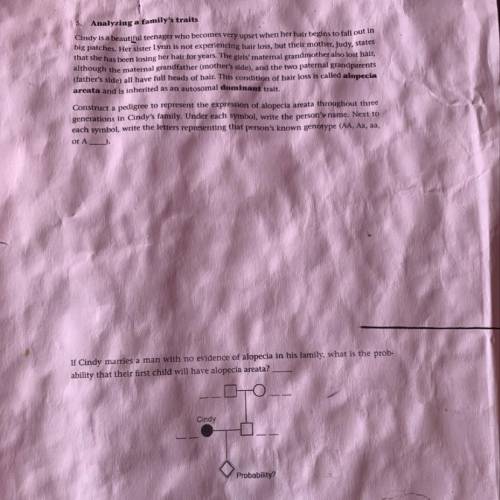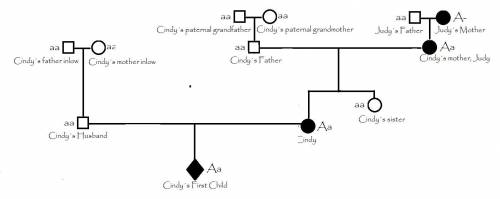
Biology, 24.07.2020 20:01 lucywood2024
5. Analyzing a family's traits
Cindy is a beautiful teenager who becomes very upset when her hair begins to fall out in
big patches. Her sister Lynn is not experiencing hair loss, but their mother, Judy, states
that she has been losing her hair for years. The girls' maternal grandmother also lost hair,
although the maternal grandfather (mother's side), and the two paternal grandparents
(father's side) all have full heads of hair. This condition of hair loss is called alopecia
areata and is inherited as an autosomal dominant trait.
Construct a pedigree to represent the expression of alopecia areata throughout three
generations in Cindy's family. Under each symbol, write the person's name. Next to
each symbol, write the letters representing that person's known genotype (AA, Aa, aa,
or A
If Cindy marries a man with no evidence of alopecia in his family, what is the prob-
ability that their first child will have alopecia areata?
Cindy
Probability?


Answers: 2


Another question on Biology

Biology, 21.06.2019 15:20
Which of the following is a cost of urbanization? a-cities can provide a high standard of living. b-cities are hubs of entertainment and education. c-paving over land changes the environment. d-job opportunities are greater in urban centers.
Answers: 1

Biology, 21.06.2019 17:00
In tossing one coin 10 times, what are your chances for tossing a head? a tail? 2. in tossing one coin 100 times, what are your chances for tossing a head? a tail? 3. in tossing one coin 200 times, what are your chances for tossing a head? a tail? deviation = ((absolute value of the difference between expected heads and observed heads) + (absolute value of the difference between expected tails and observed tails)) divided by total number of tosses. this value should always be positive. 4. what is the deviation for 10 tosses? 5. what is the deviation for the 100 tosses? 6. what is the deviation for 200 tosses? 7. how does increasing the total number of coin tosses from 10 to 100 affect the deviation? 8. how does increasing the total number of tosses from 100 to 200 affect the deviation? 9. what two important probability principles were established in this exercise? 10. the percent of occurrence is the obtained results divided by the total tosses and multiplied by 100%. toss the coins 100 times and record your results. calculate the percent occurrence for each combination. percent head-head occurrence: percent tail-tail occurrence: percent head-tail occurrence:
Answers: 1

Biology, 21.06.2019 19:30
You have 2 plants of the same type and same size, same amount of leaves. one of them is put inside the house and the other one is put in the balcony. you water them saturday, one plant with 200 ml and the other with 400 ml of water. which one of your plants need less water? explain.
Answers: 1

Biology, 21.06.2019 20:30
Which of the following is a common danger of commercial fishing?
Answers: 1
You know the right answer?
5. Analyzing a family's traits
Cindy is a beautiful teenager who becomes very upset when her hair b...
Questions

Mathematics, 02.01.2022 14:00





History, 02.01.2022 14:00




Social Studies, 02.01.2022 14:00






Mathematics, 02.01.2022 14:00

Mathematics, 02.01.2022 14:00

Mathematics, 02.01.2022 14:00






